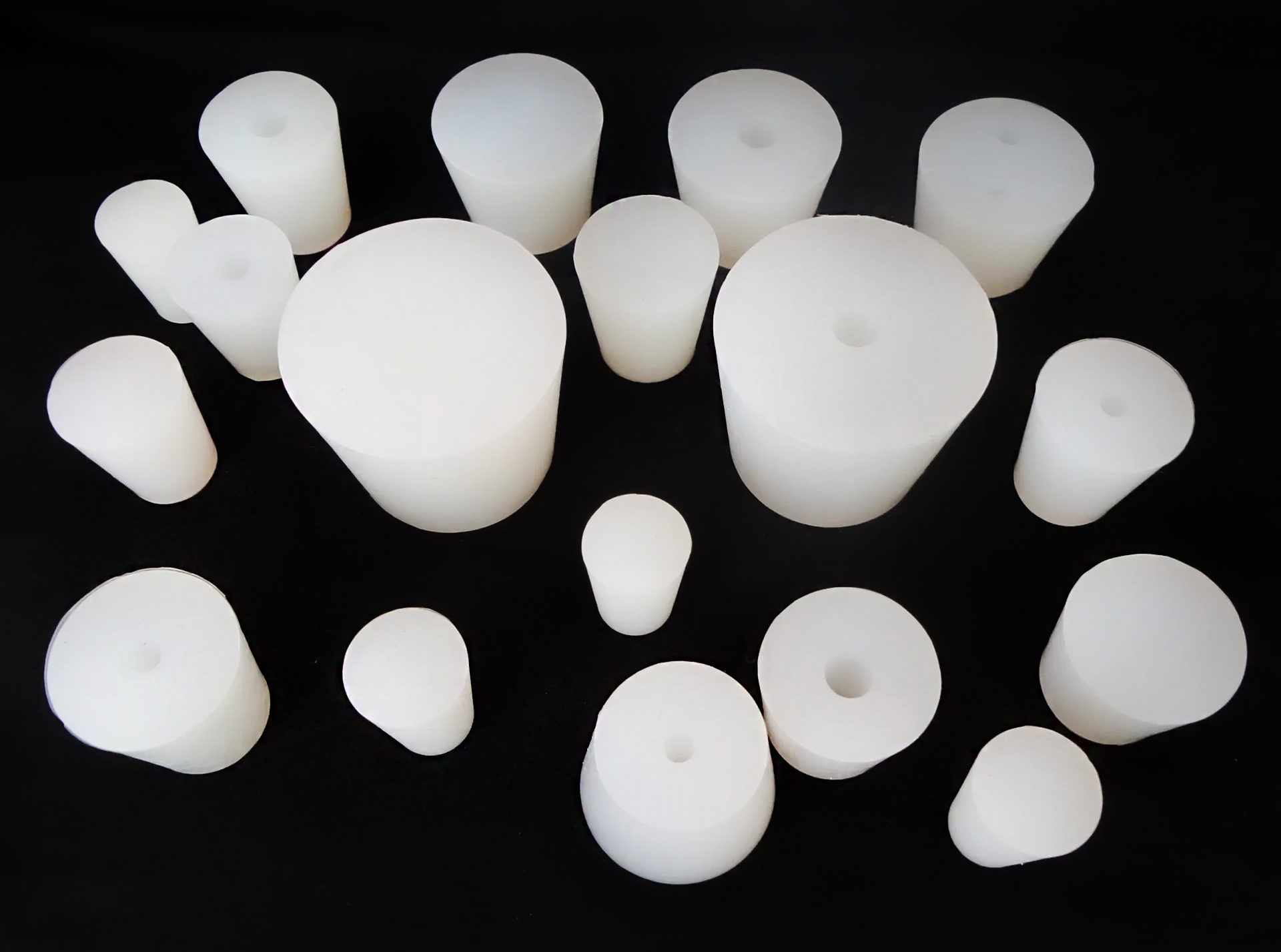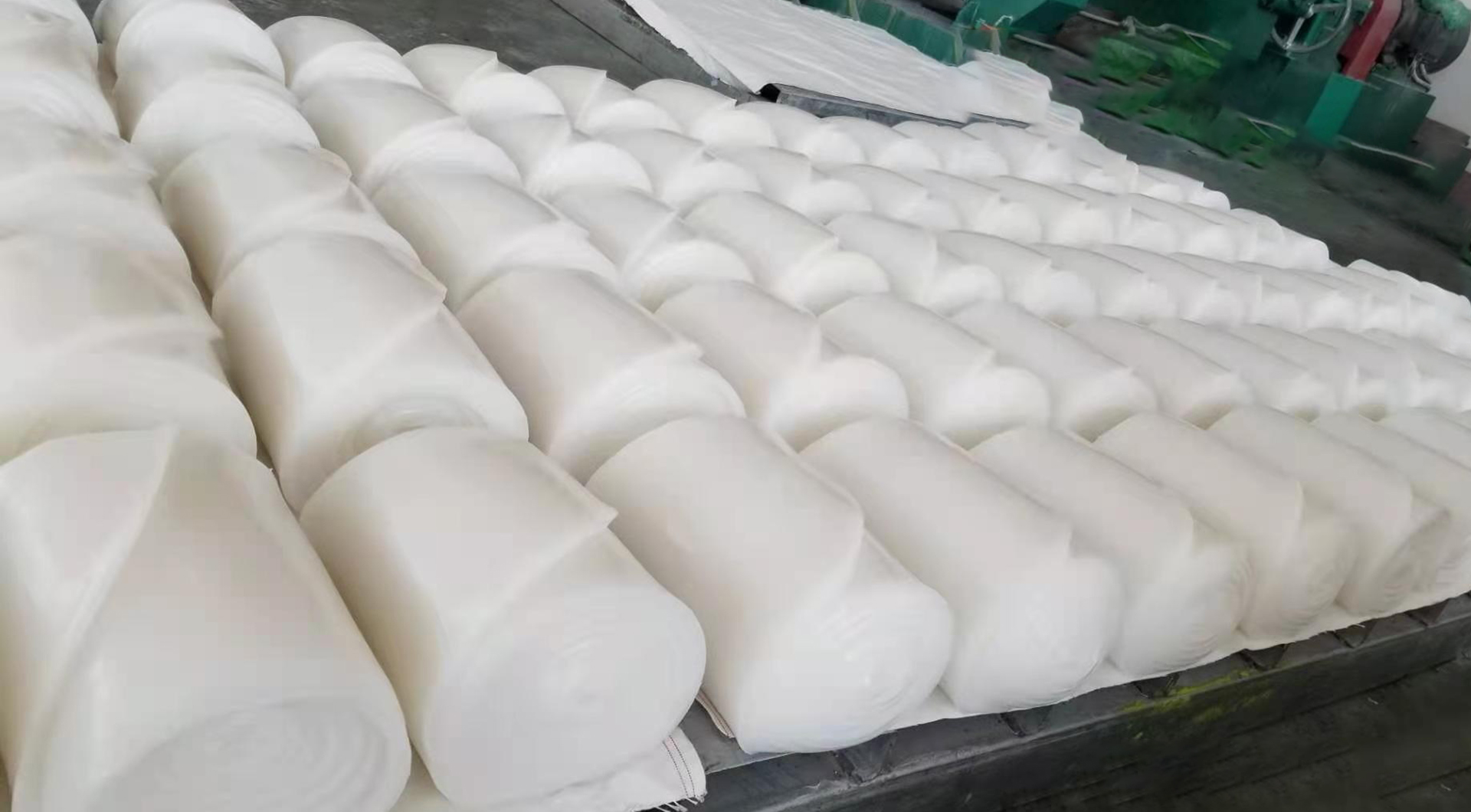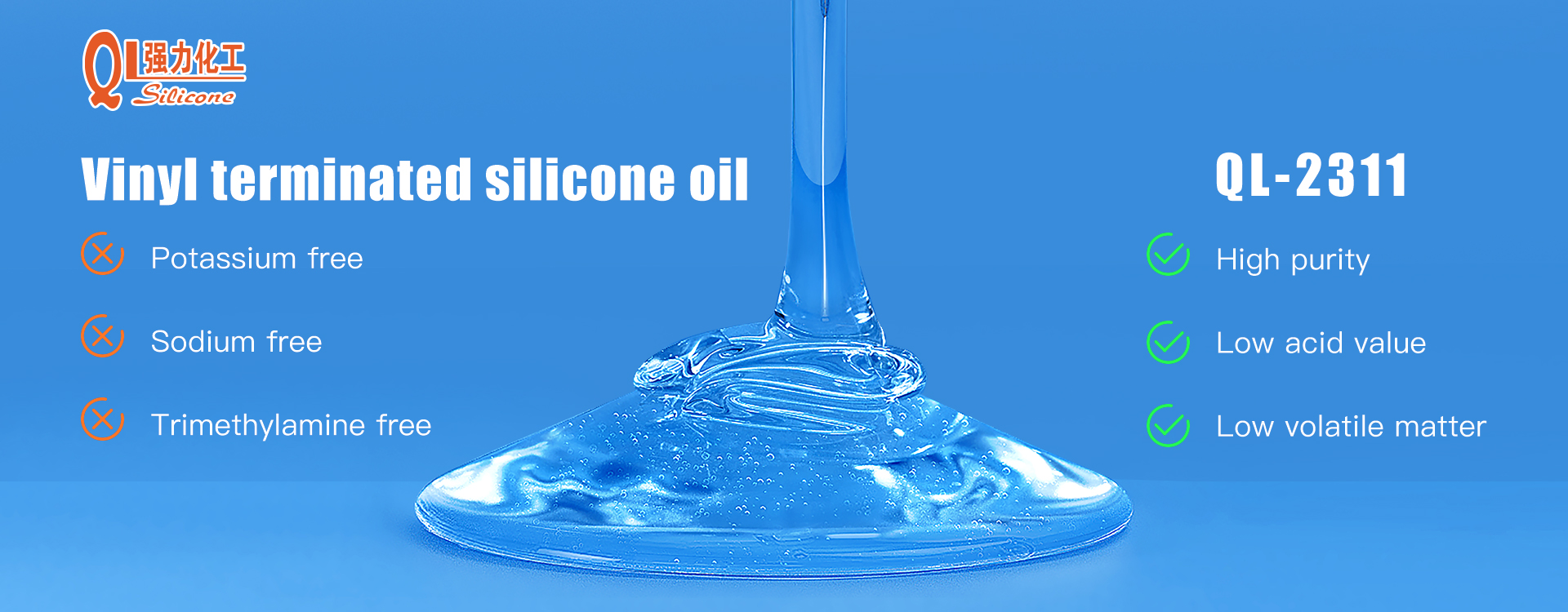
3.1 Species and characteristics
RTV silicone rubber has a low relative molecular weight and is usually a viscous liquid. According to its vulcanization mechanism and application process, it can be divided into one-component RTV silicone rubber and two-component RTV silicone rubber.
3.1.1 One-component RTV silicone rubber
One-component room temperature vulcanized silicone rubber is mixed with hydroxyl-terminated low-molecular-weight silicone rubber and reinforcing agent, dried and dehydrated, and then added with a cross-linking agent (containing a hydrolyzable polyfunctional siloxane). At this time, mixing The glue has become a polymer containing multi-functional end groups. It is packaged in a closed container and is in contact with moisture in the air when it is extruded, so that the functional groups in the rubber are hydrolyzed to form unstable hydroxyl groups, and then condensed and cross-linked to form an elastomer.
One-component RTV silicone rubber can be divided into deacidification type and non-deacidification type according to the type of crosslinking agent. The former is widely used, and the crosslinking agent used is acetoxysiloxane (such as methyltriacetoxysilane or methoxytriacetoxysilane), which releases acetic acid as a by-product during the vulcanization process, which is corrosive to metals. effect. There are many types of non-deacidification condensation vulcanization types, among which there is a dealcoholization condensation vulcanization type that uses alkoxy (such as methyltriethoxysilane) as a crosslinking agent. This reaction only depends on the action of moisture in the air, and the vulcanization is slow. Alkyl titanate vulcanization accelerators need to be added, and alcohols are released during vulcanization, which has no corrosive effect and is most suitable for electrical insulation products. In addition, there are deamination condensation vulcanization using silazane as a crosslinking agent (organic amine is released during vulcanization, which has an odor and is corrosive to copper) and deoxime vulcanization using acetone oxime and butanone oxime as a crosslinking agent, Deamidation vulcanization and deketone vulcanization type with fast vulcanization speed, etc.
According to the modulus of the product, it can be divided into low modulus (deamidation type), medium modulus (suitable for building sealant) and high modulus (dealcoholization type); according to the practical performance of the product, it can be divided into general type and special type. There are two types of products, and the special types include flame-retardant, surface-coatable, mildew-proof and pollution-resistant.
One-component room temperature vulcanized silicone rubber has good adhesion to various materials (such as metal, glass, ceramics, etc.), and is particularly convenient to use. Generally, no weighing, stirring, and defoaming operations are required. Vulcanization starts from the surface and proceeds gradually to the depth. One-component room temperature vulcanizing silicone rubber is mainly used as an adhesive and as a sealing gap material in the construction industry.
3.1.2 Two-component RTV silicone rubber
The vulcanization of this type of rubber is carried out by the hydroxyl group of the raw rubber under the action of a catalyst (organotin salt, such as dibutyltin dilaurate, stannous octoate, etc.) It can be divided into dealcohol condensation vulcanization, dehydrogenation condensation vulcanization, dehydration condensation vulcanization and dehydroxylamine condensation vulcanization, among which the dealcoholization type is the most common. Two-component room temperature vulcanized silicone rubber is usually mixed with raw rubber, filler and crosslinking agent as one component, raw rubber, filler and catalyst as another component, and the two components are mixed by metering when used. The vulcanization time of the two-component mainly depends on the amount of catalyst used, the larger the amount, the faster the vulcanization. In addition, the higher the ambient temperature, the faster the vulcanization; there is no internal stress, no shrinkage, no expansion during vulcanization, and the condensation reaction occurs simultaneously inside and on the surface during vulcanization, so there is no difficulty in deep vulcanization of thick products. It has no adhesion to other materials, and it needs to use surface treatment agent as primer when it is bonded to other materials. Two-component room temperature vulcanized silicone rubber can be used as molding and potting materials.
Room temperature vulcanizing silicone rubber can be made into different viscosities according to the application requirements, generally there are fluid grade, medium consistency grade and consistency grade. Fluid-grade rubber is fluid, suitable for pouring and spray gun operation; if lower viscosity rubber is required (when pouring into narrow gaps), methyltriethoxysilane or its oligomers can be infiltrated into the rubber, and can also be used Dilute with methyl silicone oil 201. The viscosity of the medium-consistency glue is just enough to flow fully without dripping down completely, and a product with a smooth surface can be obtained, which is suitable for gluing and dipping. Consistency grade rubber has a putty-like consistency, which can be operated by hand, scraper or caulking knife, and can also be applied to various fabrics by calendering.
In recent years, room temperature vulcanized silicone rubber has been very active in improving research. With the expansion of application areas, there have been high-adhesion, high-strength, high-elongation, low-modulus, flame-retardant, oil-resistant, and fast-curing types. New varieties.

3.2 Coordination
3.2.1 Vulcanizing agent
One-component room temperature vulcanized silicone rubber mainly relies on moisture in the air for crosslinking reaction, and the rubber material should be stored in airtight storage before use; in two-component room temperature vulcanized silicone rubber (except addition reaction system), silicone rubber containing terminal hydroxyl Commonly used vulcanizing agents are silicate (such as ethyl orthosilicate) and titanate (such as n-butyl titanate), etc.; catalysts mainly use organotin salts, such as dibutyltin dilaurate, stannous octoate, etc. wait. Adjusting the amount of vulcanizing agent and catalyst can change the vulcanization rate. The amount of vulcanizing agent is generally 1 to 10 parts; the amount of catalyst is generally 0.5 to 5 parts. Tests have shown that the catalyst dibutyltin dilaurate has a corrosive effect on copper. Dibutyltin oxide [(C4H9)2SnO] or dioctyltin oxide [(C8H17)2SnO] and ethyl orthosilicate [Si(OC2H5)4] are used to corrode copper. The reflux product was used as the vulcanization system, and the vulcanized rubber was stored in contact with copper for 1 year without any corrosion.
3.2.2 Reinforcing filler
Room temperature vulcanized silicone rubber must also be added with white carbon black as a reinforcing agent, otherwise the strength will be lower than that of heat vulcanized type. Its matching method is the same as that of heat vulcanization type.
3.3 Processing
3.3.1 One-component RTV silicone rubber
One-component RTV silicone rubber must be stored in an airtight container isolated from water and air, and can generally be used within a few months. There is no need to add a catalyst when using it, just squeeze the rubber out of the airtight container to contact the air, so it is very convenient to use; it can be processed for a short time by molding, extrusion or other methods, and then exposed to the air for a certain period of time. The vulcanized material becomes an elastomer.
One-component RTV silicone rubber is an adhesive.
When used for bonding, no surface treatment agent is required, that is, it has good bonding performance to glass, ceramics, metal, wood, plastic and vulcanized silicone rubber. Because this kind of rubber is vulcanized from the surface in contact with moisture in the air at room temperature, and then gradually vulcanized inward through the diffusion of moisture. It takes a long time for the internal vulcanization of products that are too thick, so there is a certain limit to the thickness of the product (or the depth of the seal). The thickness should generally not exceed 10mm.
Multiple construction methods can be used if it is required to exceed 10mm.
The humidity of the air has a decisive influence on the vulcanization speed, the greater the humidity, the faster the vulcanization. When the climate is relatively dry and the humidity is low, water can be sprayed to increase the moisture in the air to achieve the actual required vulcanization speed.
3.3.2 Two-component RTV silicone rubber
Two-component room temperature vulcanized silicone rubber should be stored in a cool and dry place, away from direct sunlight. If the storage time exceeds 4 months, it should be inspected, and the performance can not be continued before use.
(1) Addition of catalyst
Add the catalyst to the liquid or medium-consistency room temperature vulcanized silicone rubber compound, and stir it by hand to disperse it. After mixing evenly, put the compound in a closed container to vacuum, and maintain it at 0.67-2.67kPa for 3-5 minutes. to remove air bubbles. When thick grade rubber is used, the catalyst can be mixed into the rubber compound by rubber mixer, kneader or pulper. Catalyst can be measured by weighing method or volumetric method. Since the amount of catalyst is generally only 0.5 to 5 parts, attention should be paid to mixing evenly. Room temperature vulcanized silicone rubber will be gradually crosslinked and cured after being mixed with the catalyst, so it should be prepared according to the required amount. If there is any remaining, it can be stored in a low temperature place (such as in the refrigerator) to prolong the use time.
(2) Coating of fabrics
Room temperature vulcanized silicone rubber can be added with catalyst according to the following method, and coated on various fabrics by gluing or calendering, and it does not need to be diluted with solvent to make glue.
The method of adding the catalyst during gluing is as follows: ①adding to the sizing material before gluing; ②adding to the other side of the rubberized fabric, allowing the catalyst to permeate through the cloth layer to cross-link the rubber; ③adding to the fabric to be coated before gluing. glued surface. The first method limits the operating time to be within the pot life of the rubber, otherwise it will be cured and cannot be used; the operating time of the latter two methods is not limited by the pot life of the rubber.
(3) Dissolution of glue
Common aromatic solvents, such as toluene or xylene, can be used to dissolve the rubber to prepare room temperature vulcanized dimethyl silicone rubber glue.
This glue can be dip-coated on the fabric by the universal dipping method.
(4) Bonding
Room temperature vulcanized silicone rubber can be made into adhesives to bond various materials. When used for the bonding between various vulcanized silicone rubbers and metals or non-metals (such as glass, FRP, polyethylene, polyester, etc.), the adhesive is prepared by two groups of A and B. Group A is paste-like room temperature vulcanized silicone rubber containing an appropriate amount of reinforcing filler, a small amount of titanium dioxide and iron oxide. ) and a catalyst (dibutyltin dilaurate, etc.). Mix the two components thoroughly and evenly according to the mass ratio of 9:1 before use. The active period of the adhesive is 40min (20°C, 65% relative humidity). If you want to prolong the active period, you can reduce the amount of catalyst, but the amount should not be less than 1 part, otherwise the adhesion will be deteriorated. Excessive amount of catalyst will reduce the heat resistance of vulcanizate.
The bonding process is completed at room temperature with or without pressure. The surface of the adherend should remove dirt and clean it with acetone or toluene; then apply a layer of surface treatment agent on the metal or non-metal surface, and dry it at room temperature for 1 to 2 hours (the specific time depends on the temperature and humidity at that time. After setting), the adhesive can be applied for bonding. The surface treated with surface treatment agent will not affect the adhesion effect when glue is applied within 1 week.
(5) Vulcanization
The vulcanization of two-component RTV silicone rubber is achieved by adding a liquid catalyst. The curing time varies with the amount of vulcanizing agent and catalyst, from ten minutes to 24 hours; raising or lowering the temperature can also shorten or prolong the curing time.
Room temperature vulcanized silicone rubber products generally do not need to be vulcanized in an oven, but since a small amount of volatile substances (such as ethanol) will be produced during the vulcanization process, the volatile substances are not easy to escape when the thick product is vulcanized. Secondary vulcanization method, that is, pouring or filling each time with a thickness of 10-15mm, and placing it for 30 minutes after losing fluidity, and then continuing to pour or fill. If the service temperature of thick products is higher than 150°C, it is best to heat-treat at 100°C after room temperature vulcanization to drive off volatile substances and improve the heat resistance of the product.




